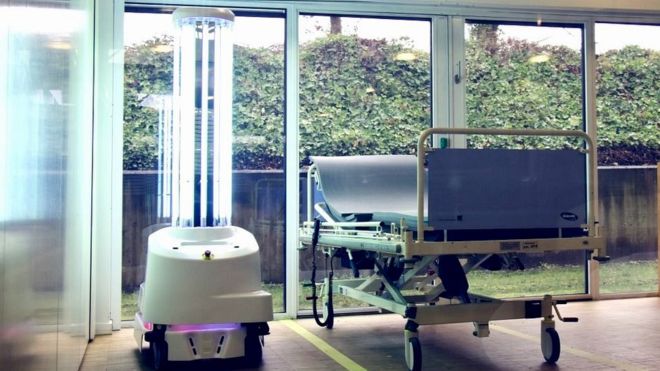Cognitive Lrn&Shr
Latest News / Articles
UVD robot was launched in early 2019, following six years of collaboration between parent firm, Blue Ocean Robotics and Odense University Hospital where Prof Kolmos has overseen infection control.

Credits : The UVD robot takes about 20 minutes to treat a room
The UVD robots have eight light bulbs that emit UV-C ultraviolet light able to destroy bacteria, virus, and other harmful microbes. once inside a room, the robot will take around 20 minutes to completely disinfect it by damaging the DNA and RNA of microbes, stopping them from multiplying. as the light is harmful to humans too, people are required to stay outside while the robot does its job. the robot is safe, reliable and eliminates human error. furthermore, it is user-friendly and is designed to be operated by every-day cleaning staff through an app.
This robot was launched in early 2019, following six years of collaboration between parent firm, Blue Ocean Robotics and Odense University Hospital where Prof Kolmos has overseen infection control.
Currently World is experiencing Coronavirus attck, this robot can play a key role in disinfecting room/s.
According to the chief executive, Per Juul Nielsen, "Demand of this robot is growing at a rapid pace due to coronavirus attack" .
He mentioned ,"truckloads" of robots have been shipped to China, in particular Wuhan. Sales elsewhere in Asia, and Europe are also up.
Also Italy has been showing a very strong demand. Due to high demand, Production has been accelerated and it now takes less than a day to make one robot at their facility in Odense, Denmark's third largest city and home to a growing robotics hub.
This robot Costs $67,000, the robot was designed to reduce the likelihood of hospital-acquired infections (HAIs) which can be costly to treat and cause loss of life.
Dr Lena Ciric, an associate professor at University College London and expert on molecular biology, agrees that UV disinfection robots can help fight coronavirus.
More than 500 healthcare facilities, mostly in the US, have the machine. In California and Nebraska, it has already been put to use sanitising hospital rooms where coronavirus patients received treatment.
In China, where the outbreak began, there has been an adoption of new technology to help fight the disease.
It is taken by many factories, offices and an airport, and a hospital in Wuhan. UVD robot has tripled output of its disinfecting robots.
According to the company, Coronavirus is very similar to other viruses like Mers and Sars. And we know that they are being killed by UV-C light.
According to doctors, as we're in the run up to having a lot of coronavirus patients in the various hospitals. It's wise to be on top of the cleaning regimes… from an infection control point of view.
To be fully effective, UV needs to fall directly on a surface. If lightwaves are blocked by dirt or obstacles, such shadow areas won't be disinfected. Therefore manual cleaning is needed first.
UV light has been used for decades in water and air purification, and used in laboratories. But combining them with autonomous robots is a recent development.
Share This:
Read all Latest Online Learning Resources News
Source: www.bbc.com
Copyright © 2018 Cognitive Lrn&Shr . all rights reserved.